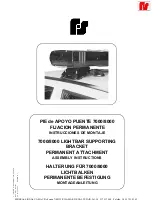
2001 VOLVO V70
http://new.volvocars.com/ownersdocs/2001/2001_V70/01v70_08a.htm[4/4/2013 10:39:05 PM]
Replacing fuses
If an electrical component fails to function, it is possible that a fuse has blown due to a temporary circuit overload.
Fuses are located in different places:
A - Relays/fuse box in the engine compartment
B - Fuse box in the passenger compartment
C - Relays/fuse box in the cargo area
A label on the inside of each cover indicates the amperage and the electrical components that are connected to each
fuse.
The easiest way to see if a fuse is blown is to remove it. Pull the fuse straight out. If a fuse is difficult to remove, you
will find a special fuse removal tool in the passenger compartment fuse box. From the side, examine the curved metal
wire to see if it is broken. If so, put in a new fuse of the
same color and amperage
(written on the fuse). Spare fuses
are stored in the fuse box in the passenger compartment. If fuses burn out repeatedly, have the electrical system
inspected by an authorized Volvo retailer.
pg. 109 Fuses in the engine compartment
Relays/fuses in the engine compartment
When replacing fuses, be sure to replace a blown fuse with a new one of the same color and amperage (written on the
fuse). Fuse amperage is also indicated on the inside of the fuse box cover.
Ordinary fuses
Location
Amperage
1 Accessories
25A
2 Auxiliary lamps (option)
15A
3 -
4 Oxygen sensors
20A
5 Crankcase ventilation heater, Solenoid valves
15A
6 Mass airflow sensor, Engine control module, Injectors 15A
7 Throttle module
10A
8 AC compressor, Accelerator pedal position sensor
10A
9 Horn
15A
















































